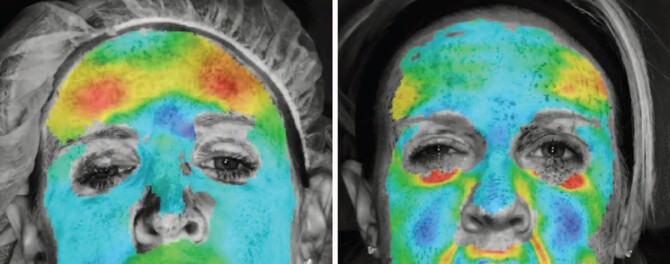Penn Medicine Study Reveals Novel Use of 3-D Imaging Technique for Precise Measurement of Injectable Wrinkle Reducers
A three-dimensional imaging technique often used in the automotive and aerospace industries for accurate measurement may be useful to measure the efficacy of injectable wrinkle reducers such as Botox and Dysport, according to new research from the Perelman School of Medicine at the University of Pennsylvania. The procedure, called three-dimensional speckle tracking photogrammetry, is described in the May issue of Plastic and Reconstructive Surgery. Authors say it has the potential to measure the efficacy of several treatments for which these types of injections are used, not only for cosmetic purposes but also to reduce facial paralysis arising from stroke and Bell’s palsy.
Photogrammetry is the use of photography to measure distances between objects. Using the new technique, researchers can measure dynamic facial wrinkles and their subsequent reduction following injection. Results are presented as a color-coded heat map. By comparing before- and after-treatment heat maps of patients, physicians can objectively evaluate wrinkle reduction and such other variables such as optimal dosage for obtaining maximum aesthetic benefit.
“There is a growing body of evidence that injectable fillers for both cosmetic and reconstructive purposes can have significant psychological benefits,” said senior author Ivona Percec, MD, PhD,director of Basic Science Research and associate director of Cosmetic Surgery in the division of Plastic Surgery at Penn. “With more people turning to this procedure, it is important to have evidence-based ways of improving cosmetic and reconstructive surgical results.” Current attempts at measuring wrinkle reduction mostly rely on static photographs and subjective visual assessments.
Injectable fillers reduce or eliminate wrinkles by relaxing the muscles responsible for their development. After treatment, the muscles gradually become less active, allowing the overlying skin to appear smoother.
In the new study, the Penn team evaluated fourteen subjects using a dual camera system and three-dimensional optical analysis. White foundation and black speckle makeup were randomly applied to each patient before and two weeks after injection of 20 units of filler in the area between the eyebrows. Movement of the speckles was tracked by the digital camera for analysis. Wrinkles in treated areas were analyzed, resulting in before- and after-treatment heat maps. In the pre-treatment heat map light blue represented wrinkles. Two weeks after treatment, the light blue had been largely replaced with light green and yellow. These new colors were representative of decreased skin compression or wrinkling.
In addition to color changes that signal improvement, the system allows precise measurement of wrinkle reduction. In the study, horizontal compression or wrinkling in the treated area decreased from 9.11 percent to 2.60 percent and from 4.83 percent to 0.83 percent in the forehead following injection. Average vertical stretch (another form of wrinkling) of the area during brow furrowing decreased from 2.51 percent to 1.15 percent, and average vertical stretch in the forehead decreased from 6.73 percent to 1.67 percent.








